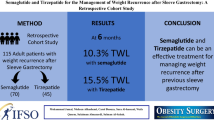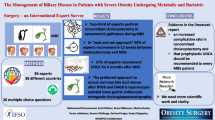Abstract
Purpose
Given that obesity is a major medical problem associated with non-alcoholic fatty liver disease and the lack of studies on postsurgery weight loss according to hepatic histology, we aimed to analyse weight loss indicators according to non-alcoholic steatohepatitis (NASH) presence one and 2 years postsurgery.
Materials and Methods
The weight loss pattern of 410 women with severe obesity (SO) was analysed after sleeve gastrectomy (SG, n = 191) and Roux-en-Y gastric bypass (RYGB, n = 219) according to NASH presence at baseline and at 12 and 24 months postsurgery. Weight loss indicators: expected BMI (eBMI), excess BMI loss percentage (%EBMIL), total weight loss percentage (%TWL) and alterable weight loss percentage (%AWL).
Results
Unlike RYGB, after SG, a higher percentage of NASH patients do not reach the eBMI 2 years postsurgery. %TWL and %AWL presented no differences after RYGB despite the presence of NASH. After SG, there is a worse ponderal evolution of all indicators analysed in the presence of NASH. Unlike SG, diabetic patients lose less weight than non-diabetic patients after RYGB. The presence of NASH in diabetics had no impact on weight loss indicators, but in non-diabetics, it had an impact, particularly in the SG group.
Conclusion
The presence of NASH suggests a worse weight loss pattern through all the analysed indicators one and 2 years after SG in women. The presence of T2DM appears to result in less weight loss after RYGB, but only non-diabetic women presenting NASH lose less weight that non-diabetic women in the absence of NASH after SG.
Graphical abstract




Similar content being viewed by others
References
Milić S, Lulić D, Štimac D. Non-alcoholic fatty liver disease and obesity: biochemical, metabolic and clinical presentations. World J Gastroenterol. 2014;20:9330–7.
Polyzos SA, Kountouras J, Mantzoros CS. Obesity and nonalcoholic fatty liver disease: from pathophysiology to therapeutics. Metab: Clin Exp. 2019;92:82–97.
Machado MV, Cortez-Pinto H. Diet, microbiota, obesity, and NAFLD: a dangerous quartet. Int J Mol Sci. 2016;17:1–20.
Cross SJ, Linker KE, Leslie FM. Non-alcoholic fatty liver disease (NAFLD) - pathogenesis, classification, and effect on drug metabolizing enzymes and transporters. Physiol Behav. 2016;176:100–6.
Li L, Liu DW, Yan HY, Wang ZY, Zhao SH, Wang B. Obesity is an independent risk factor for non-alcoholic fatty liver disease: evidence from a meta-analysis of 21 cohort studies. Obes Rev. 2016;17:510–9.
Castera L, Friedrich-Rus M, Loomba R. Noninvasive assessment of liver disease in patients with nonalcoholic fatty liver disease. Physiol Behav. 2017;176:139–48.
Rheinwalt KP, Drebber U, Schierwagen R, Klein S, Neumann UP, Ulmer TF, et al. Baseline presence of nafld predicts weight loss after gastric bypass surgery for morbid obesity. J Clin Med. 2020;9:1–12.
Wagner KT, Randall JA, Zimmermann J, Khambaty F, Brody F. Effects of liver pathology on sleeve gastrectomy outcomes. J Laparoendosc Adv Surg Tech. 2022;32:310–4.
Lassailly G, Caiazzo R, Ntandja-Wandji LC, Gnemmi V, Baud G, Verkindt H, et al. Bariatric surgery provides long-term resolution of nonalcoholic steatohepatitis and regression of fibrosis. Gastroenterology. Am Gastroenterol Assoc. 2020;159:1290-1301.e5.
Bhagwandin C, Ashbeck EL, Whalen M, Bandola-Simon J, Roche PA, Szajman A, et al. The E3 ubiquitin ligase MARCH1 regulates glucose-tolerance and lipid storage in a sex-specific manner. PLoS ONE. 2018;13:1–14.
Rauschert S, Uhl O, Koletzko B, Mori TA, Beilin LJ, Oddy WH, et al. Sex differences in the association of phospholipids with components of the metabolic syndrome in young adults. Biol Sex Differ. 2017;8:1–13.
Brunt EM, Janney CG, Di Bisceglie MA, Neuschwander-Tetri B, Bacon BR. Nonalcoholic steatohepatitis: a proposal for grading and staging the histological lesions. Am J Gastroenterol. 1999;94:2467–74.
Campos GM, Rabl C, Mulligan K, Posselt A, Rogers SJ, Westphalen AC, et al. Factors associated with weight loss after gastric bypass. Arch Surg. 2008;143:877–83.
Melton GB, Steele KE, Schweitzer MA, Lidor AO, Magnuson TH. Suboptimal weight loss after gastric bypass surgery: correlation of demographics, comorbidities, and insurance status with outcomes. J Gastrointest Surg: official journal of the Society for Surgery of the Alimentary Tract United States. 2008;12:250–5.
Fernández-Ananín S, Ballester E, Gonzalo B, Codina C, Miñambres I, Pérez A, et al. Is sleeve gastrectomy as effective in older patients as in younger patients? A comparative analysis of weight loss, related comorbidities, and medication requirements. Obes Surg. 2022;32:1909–17.
Abbassi Z, Orci L, Meyer J, Sgardello SD, Goossens N, Rubbia-Brandt L, et al. Impact of nonalcoholic steatohepatitis on the outcome of patients undergoing Roux-en-Y gastric bypass surgery: a propensity score-matched analysis. Obes Surg. 2021;32:74–81.
Kalinowski P, Paluszkiewicz R, Ziarkiewicz-Wróblewska B, Wróblewski T, Remiszewski P, Grodzicki M, et al. Liver function in patients with nonalcoholic fatty liver disease randomized to Roux-en-Y gastric bypass versus sleeve gastrectomy: a secondary analysis of a randomized clinical trial. Ann Surg United States. 2017;266:738–45.
de Brito E, Silva MB, Tustumi F, de Miranda Neto AA, Dantas ACB, Santo MA, Cecconello I. Gastric bypass compared with sleeve gastrectomy for nonalcoholic fatty liver disease: a systematic review and meta-analysis. Obes Surg. 2021;31:2762–72.
Beisani M, Sabench Pereferrer F, Vilallonga R, González López Ó, Molina López A, Del Castillo Dejardin D, et al. Seeking an initial-weight-independent metric in a Mediterranean cohort of gastric bypass patients: the %AWL revisited. Obes Surg. 2021;31:1524–32.
van de Laar AW, Emous M, Hazebroek EJ, Boerma E-J, Faneyte IF, Nienhuijs SW. Reporting weight loss 2021: position statement of the Dutch Society for Metabolic and Bariatric Surgery (DSMBS). Obes Surg United States. 2021;31:4607–11.
van de Laar AW, van Rijswijk AS, Kakar H, Bruin SC. Sensitivity and specificity of 50% excess weight loss (50%EWL) and twelve other bariatric criteria for weight loss success. Obes Surg United States. 2018;28:2297–304.
Baltasar A, Perez N, Serra C, Bou R, Bengochea M, Borrás F. Weight loss reporting: predicted body mass index after bariatric surgery. Obes Surg United States. 2011;21:367–72.
Buzzetti E, Pinzani M, Tsochatzis EA. The multiple-hit pathogenesis of non-alcoholic fatty liver disease (NAFLD). Metabolism: Clinical and Experimental. Elsevier Inc.; 2016;65:1038–48.
Franchitto A, Carpino G, Alisi A, De Peppo F, Overi D, De Stefanis C, et al. The contribution of the adipose tissue-liver axis in pediatric patients with nonalcoholic fatty liver disease after laparoscopic sleeve gastrectomy. J Pediatr Elsevier. 2020;216:117-127.e2.
Cerreto M, Santopaolo F, Gasbarrini A, Pompili M, Ponziani FR. Bariatric surgery and liver disease: general considerations and role of the gut-liver axis. Nutrients. 2021;13:1–24.
Garciacaballero M, Reyes-Ortiz A, García M, Martínez-Moreno JM, Toval JA, García A, et al. Changes of body composition in patients with BMI 23–50 after tailored one anastomosis gastric bypass (BAGUA): influence of diabetes and metabolic syndrome. Obes Surg. 2014;24:2040–7.
Armandi A, Schattenberg JM. Beyond the paradigm of weight loss in non-alcoholic fatty liver disease: from pathophysiology to novel dietary approaches. Nutrients. 2021;13:1–23.
Ryan MC, Itsiopoulos C, Thodis T, Ward G, Trost N, Hofferberth S, et al. The Mediterranean diet improves hepatic steatosis and insulin sensitivity in individuals with non-alcoholic fatty liver disease. J Hepatol Netherlands. 2013;59:138–43.
Scragg J, Avery L, Cassidy S, Taylor G, Haigh L, Boyle M, et al. Feasibility of a very low calorie diet to achieve a sustainable 10% weight loss in patients with nonalcoholic fatty liver disease. Clin Transl Gastroenterol. 2020;11:e00231.
Funding
This research was funded by Instituto de Salud Carlos III, Spain, grant number PI18/00081 (to Fàtima Sabench and Daniel del Castillo).
Author information
Authors and Affiliations
Corresponding author
Ethics declarations
Ethical Approval
All procedures performed in studies involving human participants were in accordance with the ethical standards of the institutional and/or national research committee and with the 1964 Helsinki declaration and its later amendments or comparable ethical standards. Moreover, the study was approved by the Institutional Review Board (or Ethics Committee) CEIm (protocol code 23c/2015).
Informed Consent
Informed consent was obtained from all individual participants included in the study.
Conflict of Interest
The authors declare no competing interests.
Additional information
Publisher's Note
Springer Nature remains neutral with regard to jurisdictional claims in published maps and institutional affiliations.
Key Points
- Lower percentage of patients achieved the eBMI 2 years after SG in NASH presence.
- %EBMIL at 12 and 24 months were lower in presence of NASH after RYGB and after SG.
- %TWL and %AWL were not affected by NASH presence after RYGB, but did it after SG.
- After SG, non-T2DM patients presented worse weight loss results in NASH presence.
Rights and permissions
About this article
Cite this article
Sabench, F., Bertran, L., Vives, M. et al. NASH Presence is Associated with a Lower Weight Loss One and 2 Years After Bariatric Surgery in Women with Severe Obesity. OBES SURG 32, 3313–3323 (2022). https://doi.org/10.1007/s11695-022-06175-w
Received:
Revised:
Accepted:
Published:
Issue Date:
DOI: https://doi.org/10.1007/s11695-022-06175-w




